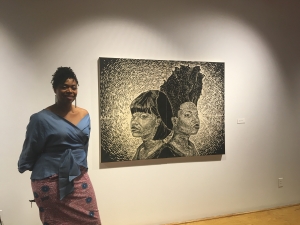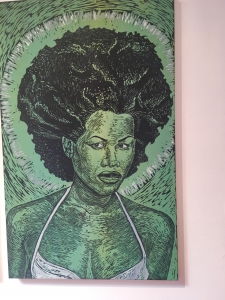
The current exhibit at Goucher College’s Rosenberg Gallery is titled Sitting Pretty and features art by painter, printmaker, and MICA professor LaToya M. Hobbs. The exhibit contains striking woodcut and monotype portraits that, according to Hobbs, aim to “show a more holistic view of what black women are . . . and how we present ourselves.” At Hobbs’ artist reception on September 27, curator Sheena M. Morrison said that these portraits “[convey] a narrative about women inventing their own measures of beauty.”

Hobbs captures a beautiful intimacy in the pieces of Sitting Pretty, which is part of a larger collection called Beautiful Uprising. Elements of the personalities of the women in these portraits are shown, such as the playfulness of Crystal (who is featured twice in this exhibit). This is intentional; Hobbs’ subjects are women that she knows personally, which she feels “gives a greater emotional connection through the work.” She also hopes that these varied images show the range of emotions black women experience, as opposed to the strict and stifling view that black women are only ever angry. She stated at her artist reception, “I like to show that we are angry and we get mad . . . but we’re also regal. We’re also sophisticated. We’re also sassy, and that’s fine, and that’s good. We’re the spectrum of all of those things.”
Morrison stated that the inspiration for curating the pieces in this exhibit came after a conversation with Hobbs about her natural hair journey. In Sitting Pretty, Hobbs captures the versatility of black women and their hair beautifully, particularly in both double portraits that are featured in the exhibit. One of these pieces is a double self-portrait, and it displays the complicated relationship many black women have with their hair. This contemplative piece aims to create “an internal and an external dialogue” with the viewer that revolves around preferences and beliefs not only about black women’s hair, but also black women themselves. Hobbs described a comment someone gave on the piece, saying that the woman in the portrait looked angry with the other woman. She said, “I think how you perceive the piece kind of gives some insight into some of your own biases that you may not even know that you have.”
During her artist reception, Hobbs explained the process of making both woodcut and monotype works, which are both printmaking processes. “With the woodcuts,” she says, “I start with a piece of wood as my matrix and carve and then print it. With the monotype . . . you start with a piece of Plexiglas . . . and do your drawing and painting on the Plexiglas, and then you print that.” Hobbs often combines her painting and printmaking processes to create what she calls “hybrid work.” The monotype portrait “Chelsea” is an example of this; Hobbs used collage to create the patterns in the background and for the subject’s clothing and drew and painted parts of this piece. Hobbs also explained that printmaking has its roots in protest. In that sense, this medium complements these portraits well, as they rebel “against standards that [black women are] expected to uphold that we actually can never reach.”
From the mesmerizing “Shay IV” to the otherworldly “Inner Glow,” every piece in Sitting Pretty is beautifully crafted and has a refreshing tenderness inherent to it. Sitting Pretty will be on display in the Rosenberg Gallery through October 25. This exhibit is free and open to the public. More information about Hobbs’ work can be found on her website http://www.latoyamhobbs.com.
